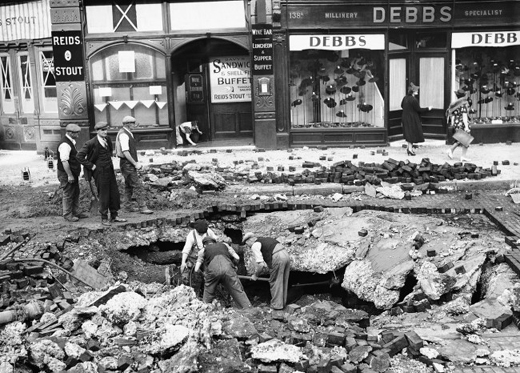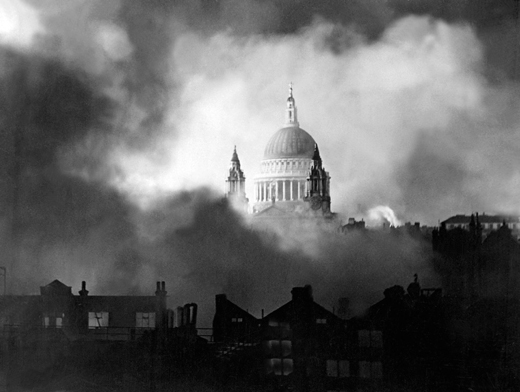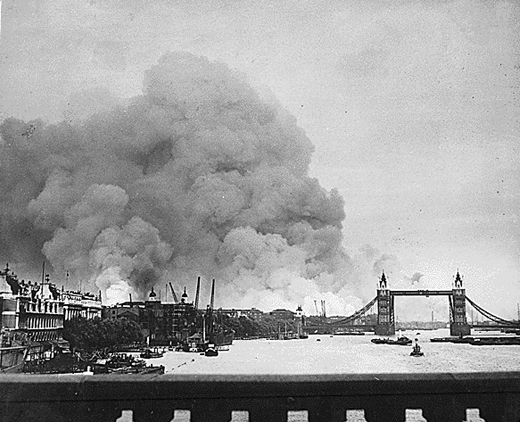Battle of Britain
Day 60
Weather - Conditions fair in most areas with some haze on the coast.
Combat - The Saturday starts relatively quiet with only a single Dornier (Do-215) reconnaissance aircraft being shot down at about 0900hrs, by Spitfires of No: 266 Squadron scrambling from Coltishall, off East Anglia. Later in the morning at 1100hrs a raid is plotted approaching Dover, which subsequently splits and bombs Hawkinge airfield and Dover without being intercepted.
It is not until mid-afternoon that another raid appears on the radar and by 1600hrs it is realized that the biggest raid yet of the conflict is heading towards the Kent coast. The Luftwaffe has amassed a raid of nearly 350 bombers and 620 fighters with one main target in mind, London.
Over the next few hours a huge aerial battle develops over most of the southeast of England as wave after wave of bombers drop their payload on the Docklands and East London. RAF Fighter Command responds and scrambles eleven squadrons and keep the remaining fighters at readiness. Within the next 30 minutes the Hurricanes of No: 43, 73, 79, 111, 242, 249, 257, 303 (Polish), 310 (Czech) and 504 Squadrons and the Spitfires of No: 19, 41, 66, 72, 234, 602, 603, 609 and 610 Squadrons have all been scrambled into action.
Hurricanes of No: 249 Squadron, scrambled from North Weald, suffer badly at the hands of Me-109's over Maidstone and lose 6 aircraft. Spitfires of No: 602 Squadron from Westhampnett, Hurricanes of No: 257 Squadron from Martlesham Heath and Hurricanes of No: 303 Squadron from Northolt also suffer high losses during the intense dogfights.
It proves to be the largest bombing raid ever made against a British city and claims the lives of over 350 people with a further 1400 seriously injured as rows of houses, buildings and warehouses collapses into the inferno.
During the night a second wave of over 300 He-111's heads up the Thames Estuary and bombs the, already ablaze, dockland areas of East London.
|
|
Following Hitler's directive to switch attacks from airfields to cities, the Germans alter the tactics of their air offensive and send a major daytime raid against London. This gives the RAF a welcome respite from the airfield attacks which have been so damaging during the last few days. The German attack on London follows from a suggestion of Hitler which coincides with Göring's own theories. The German tactic is that the RAF will be forced to commit its carefully hoarded reserves and that they can then be destroyed. Kesselring's 2nd Air Fleet is to attack London by day with its 500 bombers (including some brought from Norway and Denmark) and 600 fighters. Sperrle is to attack by night with about 300 bombers, as all his fighters have been switched to Kesselring. In addition there are about 100 Me-110s and over 200 Stukas. The British have about 350 aircraft in their front-line squadrons with more in reserve. Park is modifying his tactics slightly to cope with the bigger German formations and now intends pairing his squadrons where possible.
Dornier Do-217s Over London's Docks |
 |
In the afternoon the Germans send 300 bombers and 600 fighters to attack targets in the London dock area. The British interceptions are not well managed because the change of tactics comes as a surprise. The Luftwaffe loses 41 aircraft and Fighter Command 28 shot down and several more damaged. The bombing is most effective. 337 tons of bombs are dropped on London with the principal targets being the Woolwich Arsenal and the docks area. The bombing causes huge fires, 306 people are killed and 1337 are seriously injured. At 8:07p.m. the British GHQ issues the code-word 'Cromwell' to the Eastern and Southern Commands, meaning 'probable invasion of Great Britain within 24 hours'. During the night Sperrle follows up the attack with 250 bombers with the still-blazing fires to guide them to their target. The damage is very serious. There is little the RAF can do at night to achieve interceptions although the first airborne radar sets are coming into operation. Despite the damage done it is clear that the casualties and the disruption of civilian life are not as great as prewar fears suggested. There is no question of the Germans achieving a decisive result in these operations. These attacks become known as 'The Blitz' by the British people.
A Huge Crater at Elephant & Castle |
 |
R.A.F. Losses: 44 aircraft damaged or destroyed, 18 pilots killed or missing and 11 wounded.
Luftwaffe Losses: 62 aircraft damaged or destroyed, 68 pilots and aircrew killed or missing and 12 wounded.
NOTE: Losses include non-combat patrols and accidents.
[Battle of the Atlantic
- Outwitting escorts equipped with 'Asdic' by attacking on the surface, U-47 sinks a fourth ship, the freighter Possidon (3,840t), from Convoy SC-2 during the night.
- German motor torpedo boat S-33 sinks the Dutch steamer Stad Alkmaar (5750t) from convoy FS-273 east of Lowestoft, but the entire crew is rescued.
The Blitz
It is the beginning of a change in strategy by the Luftwaffe as they change their targets to cities. Between 5p.m. and 6p.m. 617 fighters and 348 bombers attack London. The main objective is the dock area in the East End of the city. 2 hours after the daylight raid the night raids begin and continue for almost 8 hours. 330 toms of high-explosives and 440 incendiaries are dropped causing many major fires. Fire brigades tackle more than 1,000 fires. The night raid on Londons is the first of 57 consecutive nights London is bombed. During this day the Germans lose 33 aircraft to the British 28.
[Britain, Home Front
The code-word 'Cromwell', meaning an invasion is imminent, is issued by GHQ Home Forces to the Southern and Eastern Commands and commanders in the London area. The Home Guard is put on action stations. The same warning is given to all RAF Commands.
[Germany, Home Front
In a broadcast Göring says, 'For the first time the Luftwaffe has struck at the heart of the enemy.'
[
